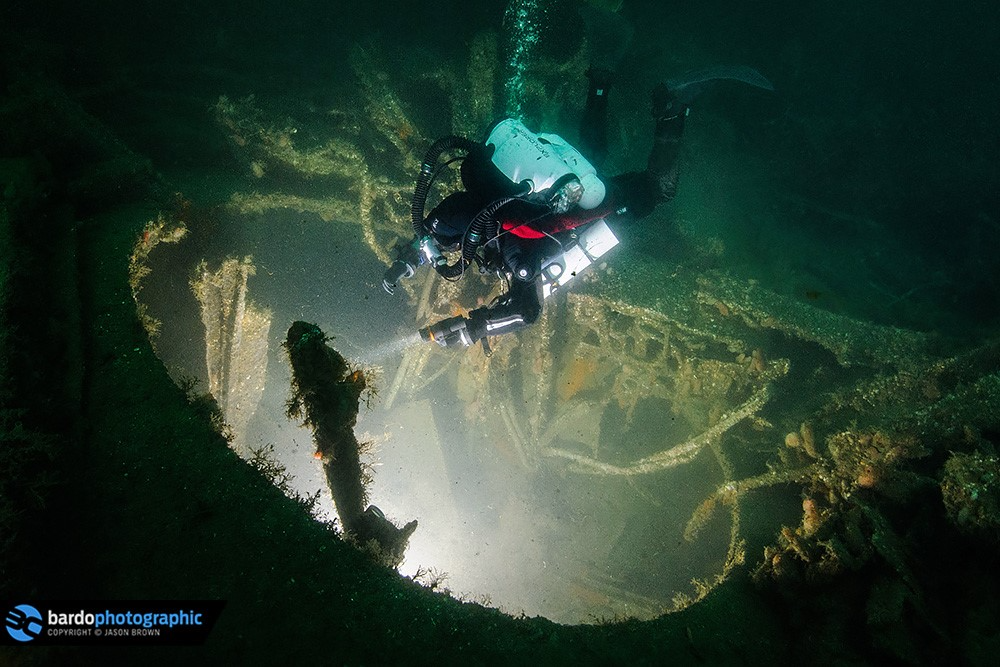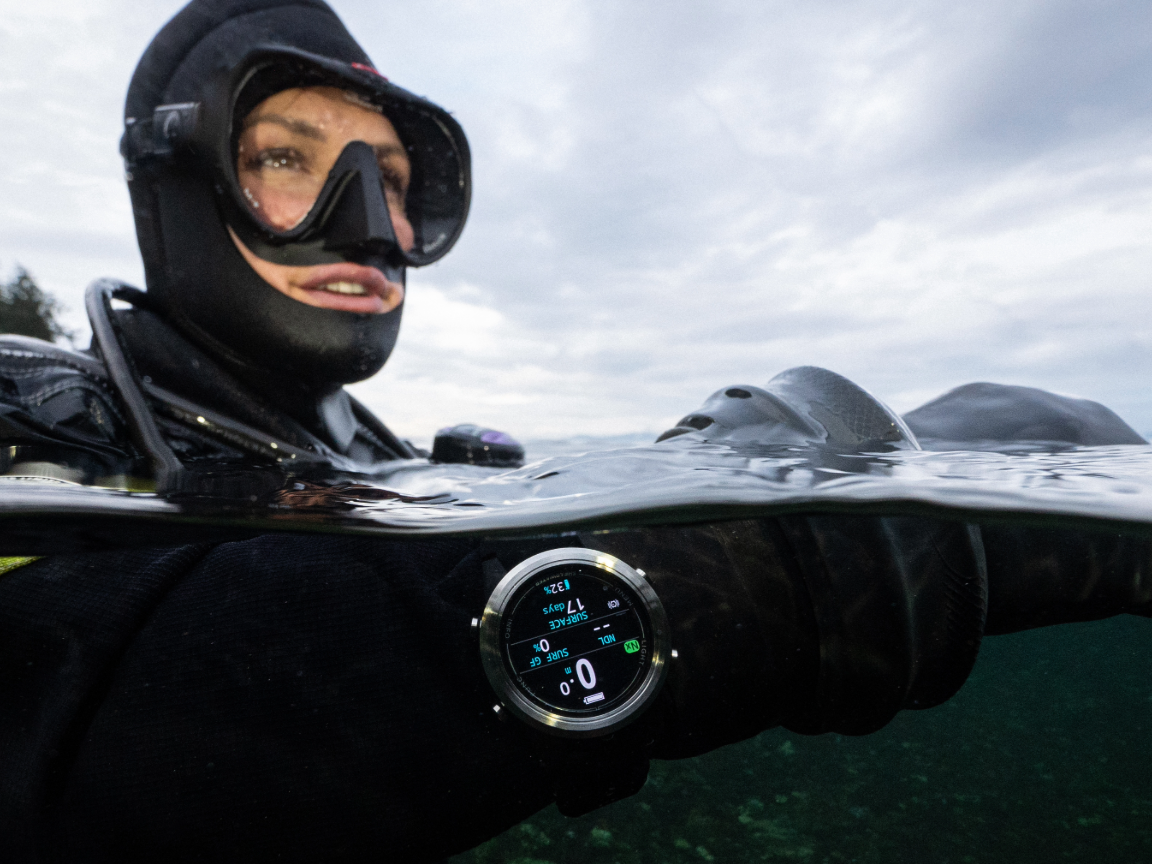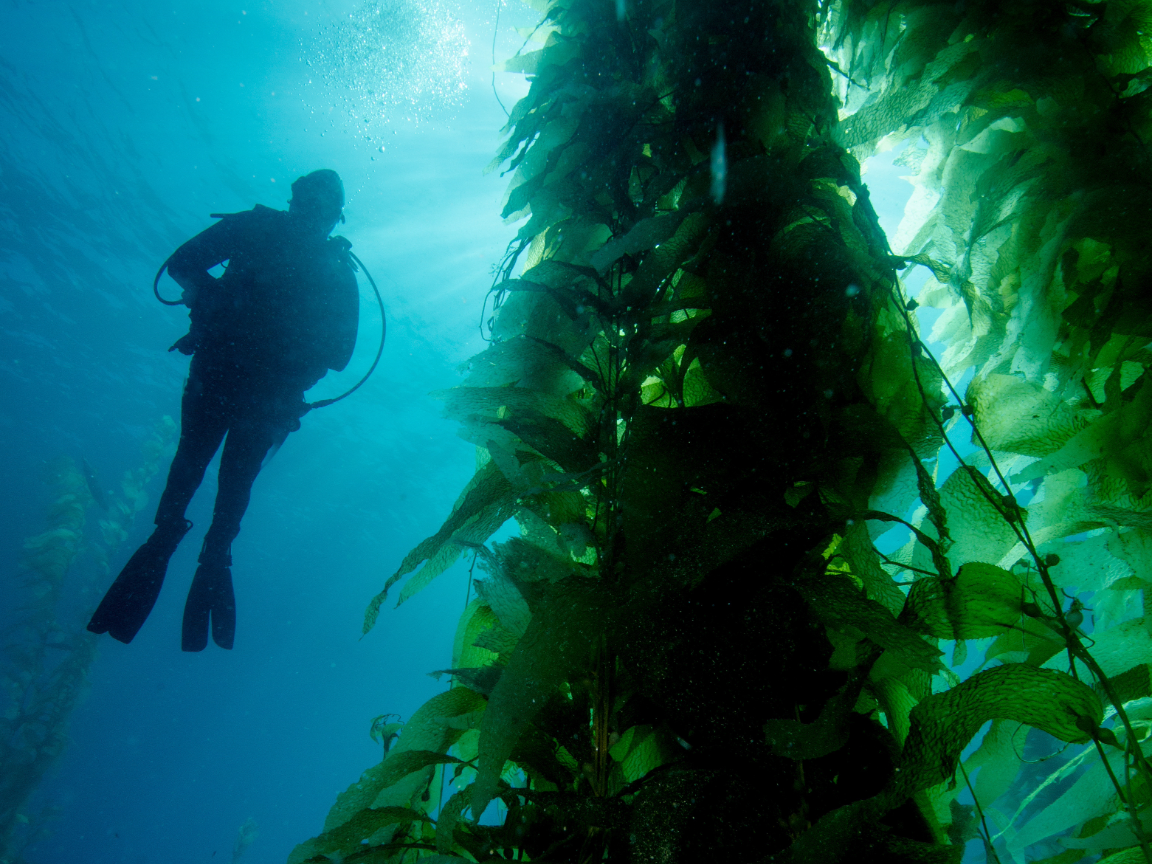
Diver Rodolfo Robatti exploring a rocky coastline. Photo Credit William Winram.
Feediving or breath-hold diving has been around for hundreds, if not arguably, thousands of years. It is our most ancient means to enter the sea to hunt and gather that which we need. Personally, I have been diving on a single breath of air for more than 40 years. I started holding on to my father’s neck when he would swim underwater in the swimming pool. This progressed to my first introduction to diving in the sea while on vacation at age 7 in Hawaii. From there, my father, a scuba instructor and search and rescue diver, began to teach my brother and I how to freedive and eventually to scuba dive.
His rationale in starting with freediving was that it developed a level of skill and understanding of the aquatic environment that would be of great benefit to the diver later when they donned a tank and regulator. He also argued that, although it was simpler in the equipment needed, it was more complicated in the physical effort and technique needed to be proficient and that the investment made in learning it well would make for much easier diving on scuba later.

Diver Robert Winram and a curious Tiger Shark. Photo Credit William Winram.
He would also often state that freediving would give you a greater respect for the underwater world and that respect would foster a desire to care and preserve the sea for the future. It turns out he was right. I have taught countless scuba divers to freedive and although not all of them continued to freedive after the course, they all said that it was invaluable to learn the basic skills and breathing techniques because it improved their experience on scuba (making them more efficient breathers) as well as giving them a greater appreciation for the sea.
I am of the opinion that all forms of diving have their place and use within the world of recreation, sport, and conservation. Rebreather diving, mixed gas diving, diving on air, and freediving all have their strengths and weaknesses, risks and rewards. What I would like to share here is my perspective as someone who is advanced open water scuba certified but who primarily uses freediving as an active tool to explore and discover our underwater world as well as to aid scientific research.
I often speak of a “sense of belonging” when teaching freediving. There is an innate sense that we belong in the sea when we are on a single breath of air. Whether it is some feeling of connection to our ancestry or other marine mammals, this sense is indisputable. For we do, in fact, belong in the sea. After all, we share the same physiological response as other marine mammals.
Like dolphins, whales, seals, etc., we have what is known as a “mammalian diving reflex”. This reflex activates when you put your face in the water. It slows the heart rate, shunts or moves the blood from the arms and legs to the core of the body, and causes the spleen to release old red blood cells back into circulation in order to safely prolong your time under the water. The oxygenated blood is prioritised for the heart and brain as they are crucial to our survival - the other organs are temporarily put on hold as the body attempts to give you more time safely underwater.

Diver Robert Winram observing a large group of mobula rays swimming past. Photo Credit William Winram.
The strength of our dive reflex is different from person to person depending on how often they dive and for how many years. However, we all have a mammalian diving reflex. This, for me, is evidence that we are meant to enter the sea on a single breath of air.
As you practice freediving mindfully, you will improve in your ability to move in the water, to quietly and proficiently navigate the aquatic world, and have the possibility to discover new experiences and encounters you would not otherwise have.
Moreover, my experience over the years has shown that often times when I am freediving, marine animals approach me because I am on a breath-hold. Their curiosity and the oddity of a human in the water overcomes their fear, and they will approach as if to “get a closer look.”

Great Hammerhead shark coming in for a closer look. Photo Credit William Winram.
I often find that when you have achieved a level of quiet proficiency in freediving, your ability to approach certain species of animals will go beyond what is possible when using scuba diving. For example, many marine creatures view the release of bubbles (unavoidable in scuba diving) as a form of aggression. A closed circuit rebreather will solve the problem of the bubbles, but you then lose a certain amount of mobility and speed in the water - something that becomes necessary with certain applications of freediving. There are equally instances where scuba diving makes more sense based on the depth you wish to work at and duration at that depth. For this reason, I have filmed and tagged on scuba. I have also arrived to the bottom in shallow water to perform a specific task only to find I am underweighted and the moment I release some air to help to settle on the bottom, any sea life that was approaching has probably swam off.
Practically speaking, at a certain level of competency, you lower your footprint in the sea. You are able to move as silently and efficiently as a human can within the underwater world. This allows you to approach marine creatures that are shy and elusive, such as scalloped hammerhead sharks for instance.

School of Scalloped Hammerhead sharks keeping their distance from the tagging team but close enough for a photo. Photo Credit @watermenproject.
I choose freediving because I like the simplicity of it. All I need is a mask, snorkel, and fins along with a weighted belt and a wetsuit. I also choose freediving because there are a myriad of useful applications for it that can fulfil a need when it comes to scientific research and conservation.
For instance, in remote atolls and regions where the infrastructure to refill tanks is not available or where the expedition does not have an expedition boat with the requisite compressor, etc. The simplicity of freediving would allow the scientific team to conduct their research in-spite of the lack of scuba tanks. Over the years, I have met many scientists who use breath-hold diving in just such a situation because they initially did not have another option, but then grew to appreciate the advantages of freediving.

Great Hammerhead shark photographed showing an acoustic tag placed directly at the base of the dorsal fin. Photo Credit William Winram.
Another example of a good application and use of freediving skills is the tagging of sharks. In particular, there are several aspects of freediving that lend themselves to the tagging work - as a freediver, you move freely within the water column, and you can and will descend to depth and return to the surface over and over (a necessity due to the need to breathe...). While either descending or returning you can easily change your trajectory to intersect an animal you wish to tag. You can adjust your depth freely within the limits of your breath-hold and depending on the sharks movements.
Case in point this past May while on expedition in Mexico, one of the lead scientists who needed to tag large whale sharks could only really move at the speed required while snorkelling or freediving. We would spot the whale shark, the boat would deposit us ahead of the shark, and we would fin like crazy to get in close enough to place the tag and to film and photograph both the tagging and the shark for later identification. This can only be done while snorkelling/freediving.

Scientist Darren Whitehead tagging a large mature whale shark as part of his ongoing research of these gentle giants. Photo Credit William Winram.
On a breath-hold, you are also able to move much faster in the water, but also much quieter to be able to intersect an animal. Whenever we are freediving to tag, there is a depth when, due to the compression, we no longer float and instead sink. This allows us to silently drop, maintaining a hydrodynamic form, using small movements of a hand or a fin to change the direction of descent and to sneak up on an unsuspecting candidate for a tag. This technique is particularly useful when dealing with extremely elusive sharks like the scalloped hammerhead (Sphyrna lewini).
It is this method that we employed with this type of shark in the Revillagigados archipelago (2013), and attempted again in the Sea of Cortez in 2022. In the former, I was present to assist Dr. Mauricio Hoyos in tagging scalloped hammerheads sharks. It had been five years since Dr. Hoyos had been able to tag a scalloped hammerhead in Revillagigedo. The reason being, as he put it, “it seems the bubbles and noise of scuba scares them off and does not allow me to get close enough to place a tag”. While the diving conditions proved difficult, with extremely heavy current and the sharks staying below 20m, I still managed to place 10 tags in 6 days.
Another advantage to freediving is that it does not risk the death of the shark. Hammerhead sharks are a very fragile species and it has been scientifically demonstrated that they do not survive well with the stress of being caught on a hook and line, yielding a very high mortality rate on long lines.
Typically during tagging and biopsy work, we try to work in a group of three - one tagging, one photographing and/or filming, and the third keeping a look out for boats, other animals, and our safety. This is particularly necessary when working with a species like the great white shark (Carcharodon charcharias), but also ideal for all other species. This allows us to bring back images from the tagging process as well as photos of the animals which all bear unique markings or patterns on their bodies (fin shape, skin pigmentation, etc.), helping us with identifying individual sharks.

Great White shark photographed above highlighting the acoustic tag placed next to the base of the dorsal fin earlier in the day. Photo Credit William Winram.
Tagging using a modified speargun on a breath-hold is the least intrusive way to place tags. As freedivers, we can move silently towards the animal, aim for the area next to the dorsal fin, and fire the spear shaft which penetrates the shark's skin to a depth of a few centimeters. As the shaft releases when the animal swims off, the dart and the transmitter are left behind. The skin heals in 48 - 72 hours, and we usually see the animals returning within a few minutes to hours.

At the last moment a great white shark approaching our team turns and veers away requiring the team to be patient in waiting for the animal to decide to swim in for a closer look thus allowing the team to place the tag. Photo Credit @watermenproject.
With the current decline in shark populations and overall health of our oceans, it is imperative that we find solutions to science that minimize or erase the risk of mortality to the animals we wish to study. For this reason, tagging while freediving is an important addition to the scientific repertoire and a complement to other forms of diving.
Learn more about the Watermen Project here.
---
Written by William Winram
Born and raised in the Canadian Pacific Northwest in the sixties, William Winram is a one-of-a-kind storyteller who holds several world records in the sport of freediving (breath-hold diving). Accomplished photographer, filmmaker and story teller, William is an Oceans Ambassador for the IUCN and a Fellow of the Explorers club.
He is considered an expert in shark behavior, and as a natural evolution, in January 2012, he founded the Watermen Project (watermenproject.org) , an NPO where breath-hold diving is at the service of ocean conservation. Scientists are assisted in their research to understand sharks which are savagely slaughtered in the number of 100 million individuals every year.
Today, William gives talks and teaches on topics ranging from risk and stress management to optimized breathing and breath-hold diving. When he is called in to support ocean research, he lends his time for ocean conservation projects around the world, as well as his commitments as Oceans Ambassador. He has been exploring the underwater world and sharing stories of his endeavors on a single breath of air for more than four decades.




